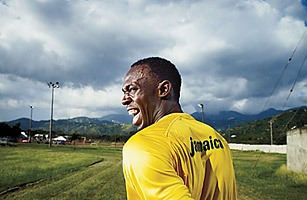
(3 of 4)
Boltology Lesson
In October 2004, Bolt switched coaches, to Glen Mills, a revered veteran. Mills was a scientist of speed, fixing a few important glitches in Bolt's running machine. Bolt leaned too far back during his dashes, which threw him off balance. According to Bolt, Mills also loosened the engine. "My shoulder was always up, like this," Bolt says, imitating a shrug. "I had to put them down and lean forward. When you run like this" — again the shrug — "you're really, really tight. And when you start getting tighter, you're automatically going to start getting slower." The cantankerous Mills improved Bolt's work habits but didn't drill his pupil too hard. A dictatorship would never fit Bolt's loosey-goosey vibe.
Bolt's exploits sent physicists and biologists racing to predict the limits of human speed. In a paper titled "Velocity Dispersions in a Cluster of Stars: How Fast Could Usain Bolt Have Run?," Norwegian physicist Hans Eriksen, a cosmologist who recently studied the origins of the universe at Caltech's Jet Propulsion Laboratory, predicted that if Bolt hadn't celebrated at the end of his 100-m victory in Beijing and had instead matched the acceleration of the second-place runner or slightly exceeded it, he would have clocked anywhere from 9.55 to 9.61 sec. rather than his winning 9.69. Two Dutch statisticians employed something called extreme-value theory to call 9.51 sec. the ultimate 100-m record. Stanford biologist Mark Denny reached into his math tool kit to predict that 9.48 sec. would be the human speed limit.
So how does Bolt burst through speed barriers? While watching a video of Bolt's 100m race in Berlin, Ralph Mann, a biomechanist who works with the U.S. track-and-field team, explains. First off, when he leans over at the start, Bolt's butt is up higher than those of the other racers. "That produces power from the big monster muscles in your body," says Mann. "The big old gluteus maximus, the big old hamstring." For years, tall guys like Bolt were discouraged from running the 100 m because it took longer for their limbs to wind up at the start. But 10 m into the Berlin 100, Bolt is already in second place. At 20 m, he's in first place. "He should not be ahead at that point," says Mann. "If he was in seventh, I would be impressed. Exceptional is too soft a word. He's astounding as a starter."
Once Bolt gets in gear at the beginning, his long legs are a lethal advantage. Runners achieve faster speeds by hitting the ground with greater force than do their competitors. All lite sprinters are blessed with the fast-twitch muscle fibers that can produce such explosive pounding. But if you stop the tape 4.8 sec. into Bolt's record-breaking 100 m in Berlin, you'll see that his left knee is particularly high off the ground. This position, combined with the length and strength of Bolt's legs, creates the power that spells second or worse for the other runners.
Given track's sordid history, there will always be those wondering if pharmacology — namely, performance-enhancing drugs — more than physics is responsible for Bolt's speeds. Yes, Bolt has passed every drug test. But so did U.S. sprinter Marion Jones and other runners later unmasked as cheats. Science has outrun the testing. When asked if there are whispers, Wallace Spearmon, an American sprinter and one of Bolt's best friends, replies, "Yes, there always are."
Claire Nelson, a Jamaica native who founded the Institute of Caribbean Studies in Washington, insists that a "culture of shame" in her home country will act as "preventative medicine" for Bolt against getting caught using drugs. Bolt agrees with Nelson's assessment. "Because I'm doing extraordinary things, people might say, 'Blah, blah, blah,'" Bolt explains. "I know I'm clean. One thing in Jamaica, we take our sports very, very seriously. One person who got caught years ago had to leave the country because we don't like to be disgraced." Does he think he would eventually get kicked out of Jamaica if he was busted? "I probably would. It would be traumatic."